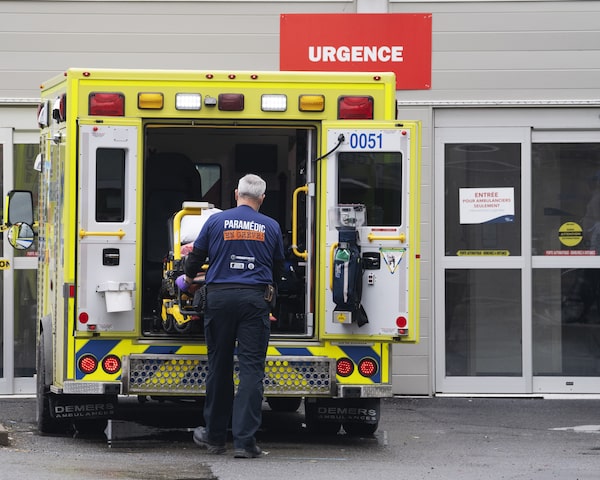With Canada’s colder weather comes respiratory virus season, with flus and RSV circulating alongside the COVID-19 virus that remains with us. While Canadians learned a lot about how to protect themselves from illness over the course of the pandemic, new information released by health care practitioners can help inform decisions, from availability of flu shots to any changes in COVID protocols.
We’ll be publishing an update on respiratory virus season each week. Looking for more information on the topic that you don’t see here? E-mail audience@globeandmail.com to see if we can help you.

A paramedic loads his stretcher back into the ambulance after bringing a patient to the emergency room at a hospital in Montreal, on April 14, 2022.Ryan Remiorz/The Canadian Press
The latest news
- Health officials in B.C. announced this week that a third child under the age of 10 died in December after contracting the flu. The province had previously disclosed the deaths of two other children, who experienced complications from the flu. But no national data on severe flu-related outcomes in pediatric patients are available, a major gap that is keeping clinicians in the dark, according to a Globe and Mail report this week.
- Hospitals across the country are seeing higher numbers of people coming to emergency departments or requiring hospital admission as a result of respiratory viruses, adding strain to an already stretched health care system.
Flu shots
Flu shot clinics and programs are ramping up across the country, with appointments being made available for anyone six months and older. Find out about clinics and availability for each of the provinces and territories here:
Newfoundland; Prince Edward Island; Nova Scotia; New Brunswick; Quebec; Ontario; Manitoba; Saskatchewan; Alberta; British Columbia; Yukon; Northwest Territories; Nunavut
COVID-19 boosters
The three authorized vaccines, manufactured by Pfizer-BioNTech, Moderna and Novavax, protect against the XBB.1.5 subvariant of COVID-19 and should provide good protection against the related EG.5 family. The reformulated mRNA shots from Pfizer-BioNTech and Moderna are approved for anyone six months and older. Novavax’s shot is approved for those 12 and up.
COVID-19 vaccine information for the provinces and territories can be found here:
Newfoundland; Prince Edward Island; Nova Scotia; New Brunswick; Quebec; Ontario; Manitoba; Saskatchewan; Alberta; British Columbia; Yukon; Northwest Territories; Nunavut
Flu outlook in Canada
The vast majority of flu cases in Canada are influenza A, and most of those are the H1N1 subtype. During the week that ended Dec. 30, there were 179 hospital admissions linked to the flu, 22 ICU admissions and under 5 deaths.
From Aug. 27 to Dec. 30, 2023, PHAC reports that there have been 297 ICU admissions and 69 deaths linked to the flu in Canada. Adults 65 and older and children under five accounted for the highest cumulative hospitalization rates in Canada, at 77 per 100,000 and 31 per 100,000, respectively.
Hospitalizations for COVID-19
There were 4,627 people in hospital as a result of COVID-19 during the week that ended Jan. 2, according to the Public Health Agency of Canada, virtually unchanged from the previous week, when 4,625 were in hospital.
Current health guidance for COVID-19
Symptoms of COVID-19 can vary, but generally include sore throat, runny nose, sneezing, new or worsening cough, shortness of breath or difficulty breathing, feeling feverish, chills, fatigue or weakness, muscle or body aches, new loss of smell or taste, headache, abdominal pain and diarrhea. According to Health Canada, you may start experiencing symptoms anywhere from one to 14 days after exposure. Typically, symptoms appear between three to seven days after exposure.
Health Canada advises following the testing guidelines provided by your local public health authority if you have symptoms or have been exposed to a person with COVID-19. If you test positive, immediately isolate yourself from others, including those in your household, and follow the advice of your local public health authority on isolation requirements.
How to protect yourself and your loved ones from respiratory viruses
Respiratory viruses are spread from person to person or through contact with contaminated surfaces, so it’s important to protect against both forms of transmission. Health Canada recommends wearing a medical mask or respirator, washing your hands regularly or using hand sanitizer, covering your coughs and sneezes, and cleaning and disinfecting high-touch surfaces and objects. If you feel sick, stay home and limit contact with others.
What are your questions, thoughts and concerns about this year's respiratory virus season?
The Globe and Mail's weekday news podcast, The Decibel, wants to help you answer the questions you may have about RSV, COVID-19 and influenza this winter.
 Carly Weeks
Carly Weeks